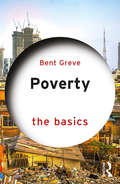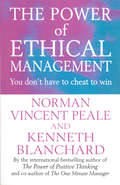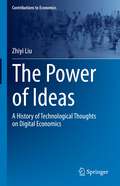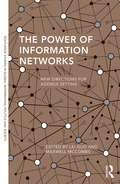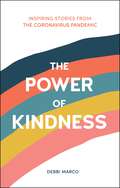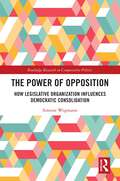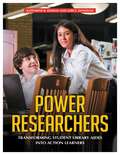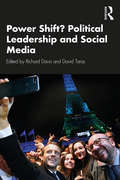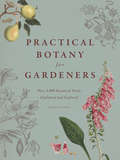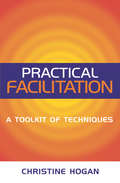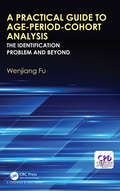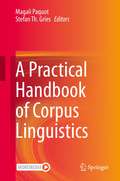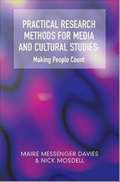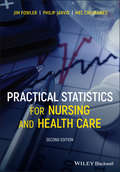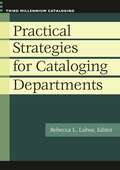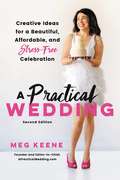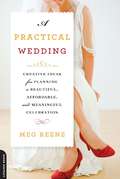- Table View
- List View
Poverty: The Basics (The Basics)
by Bent GrevePoverty has dire consequences on the ability to fulfil one’s aspirations for life. Poverty has strong implications for social cohesion and societies’ abilities to function in harmonious ways. This book presents the readers with the core concepts, latest development and knowledge about policies that work to eliminate absolute poverty. This volume shows what the consequences are for the quality of life of those living in poverty. It describes life for people in poverty in general, but also deals more specifically with children, in-work poverty and the elderly, thus providing a life, generational and global perspective on poverty, including the impact on people’s happiness levels. The book also discusses policies aimed at poverty reduction, such as changes to the labour market – including the risk of working poor – and shows that there is a variety of possible instruments available to reduce poverty. These range from direct provision of social security to ensuring education and a better functioning labour market. Written in an engaging and accessible style, the book provides a succinct insight into the concept of poverty, how to measure it, the situation of poverty around the globe as well as different types of possible interventions to cope with poverty. Supporting theory with examples and case studies from a variety of contexts, suggestions for further reading, and a detailed glossary, this text is an essential read for anyone approaching the study of poverty for the first time.
Poverty: The Basics (The Basics)
by Bent GrevePoverty has dire consequences on the ability to fulfil one’s aspirations for life. Poverty has strong implications for social cohesion and societies’ abilities to function in harmonious ways. This book presents the readers with the core concepts, latest development and knowledge about policies that work to eliminate absolute poverty. This volume shows what the consequences are for the quality of life of those living in poverty. It describes life for people in poverty in general, but also deals more specifically with children, in-work poverty and the elderly, thus providing a life, generational and global perspective on poverty, including the impact on people’s happiness levels. The book also discusses policies aimed at poverty reduction, such as changes to the labour market – including the risk of working poor – and shows that there is a variety of possible instruments available to reduce poverty. These range from direct provision of social security to ensuring education and a better functioning labour market. Written in an engaging and accessible style, the book provides a succinct insight into the concept of poverty, how to measure it, the situation of poverty around the globe as well as different types of possible interventions to cope with poverty. Supporting theory with examples and case studies from a variety of contexts, suggestions for further reading, and a detailed glossary, this text is an essential read for anyone approaching the study of poverty for the first time.
The Power Of Ethical Management (Positive Business Ser.)
by Kenneth Blanchard Norman Vincent PealeTHE POWER OF ETHICAL MANAGEMENT proves that you don't have to cheat to win. It shows how to bring integrity back into business. It offers hard-hitting, practical and ethical strategies that build profits, productivity and long-term success. Written as a parable this simple book gives you an immensely useful set of tools; from a three-step 'Ethics Check' that helps you evalutate any action or decision, to the Five Ps' of ethical behaviour which will clarify your purpose and your goals. This is no theoretical treatise: peale and Blanchard speak from their enormous and unique experience, and show how integrity pays.
The Power of Ideas: A History of Technological Thoughts on Digital Economics (Contributions to Economics)
by Zhiyi LiuAs the first academic monograph that a Chinese scholar discusses the histories of thoughts and ideas related to the development of digital economics, this book aims to make research from the perspective of the history of ideas and discuss the ideas influencing the development of digital economics and the evolution of related theories and thoughts with the methodology of interdisciplinary research.The human society is in the stage of major historic transition and enters the digital world with the main goal of developing the artificial world. In this world, the development of digital economics is significantly characterized by the deep interaction between the real and the virtual worlds, while the key triggering this paradigm reform is the evolution of ideas since the modern times. While involving the field of computer, these thoughts are also related to the fields of philosophy, ethics, communication and economics. Therefore, the results of the research on the history of ideas related to digital economics are required to really understand the depth of this discipline. If computationalism is the most important paradigm evolution of natural science, the most important paradigm evolution of social science is interdisciplinary complex science. In the meantime, this book is the most significant in understanding the nature of paradigm evolution related to the development of digital economics from the perspective of complex science and interdisciplinary systematic researches.Digital economics is in the foundation-laying phase, while this book mainly aims to historically narrate the thoughts of this discipline and hopes that readers can understand the influence of ideas in the old era on shaping the disciplines in the new era while exploring this new discipline. The construction of digital economics is a process of evolution. This book will be helpful to understand the underlying logic of the ideas constructed by the thinkers in different fields.
The Power of Information Networks: New Directions for Agenda Setting (Routledge Studies in Global Information, Politics and Society)
by Lei Guo Maxwell McCombsThe news media have significant influence on the formation of public opinion. Called the agenda-setting role of the media, this influence occurs at three levels. Focusing public attention on a select few issues or other topics at any moment is level one. Emphasizing specific attributes of those issues or topics is level two. The Power of Information Networks: The Third Level of Agenda Setting introduces the newest perspective on this influence. While levels one and two are concerned with the salience of discrete individual elements, the third level offers a more comprehensive and nuanced perspective to explain media effects in this evolving media landscape: the ability of the news media to determine how the public associates the various elements in these media messages to create an integrated picture of public affairs. This is the first book to detail the theoretical foundations, methodological approaches, and international empirical evidence for this new perspective. Cutting-edge communication analytics such as network analysis, Big Data and data visualization techniques are used to examine these third-level effects. Diverse applications of the theory are documented in political communication, public relations, health communication, and social media research. The Power of Information Networks will interest scholars, students and practitioners concerned with the media and their social and cultural effects.
The Power of Information Networks: New Directions for Agenda Setting (Routledge Studies in Global Information, Politics and Society)
by Lei Guo Maxwell McCombsThe news media have significant influence on the formation of public opinion. Called the agenda-setting role of the media, this influence occurs at three levels. Focusing public attention on a select few issues or other topics at any moment is level one. Emphasizing specific attributes of those issues or topics is level two. The Power of Information Networks: The Third Level of Agenda Setting introduces the newest perspective on this influence. While levels one and two are concerned with the salience of discrete individual elements, the third level offers a more comprehensive and nuanced perspective to explain media effects in this evolving media landscape: the ability of the news media to determine how the public associates the various elements in these media messages to create an integrated picture of public affairs. This is the first book to detail the theoretical foundations, methodological approaches, and international empirical evidence for this new perspective. Cutting-edge communication analytics such as network analysis, Big Data and data visualization techniques are used to examine these third-level effects. Diverse applications of the theory are documented in political communication, public relations, health communication, and social media research. The Power of Information Networks will interest scholars, students and practitioners concerned with the media and their social and cultural effects.
The Power of Kindness: Inspiring Stories, Heart-Warming Tales and Random Acts of Kindness from the Coronavirus Pandemic
by Debbi MarcoKindness mattersWhen times are hard, we pull together. Despite the difficulties of life during the coronavirus pandemic, love and kindness prevail.Dive into this heart-warming book and discover the many uplifting and inspiring acts of kindness that have come from the crisis. Read about the postman who donned fancy dress while doing his rounds to bring a smile to his community, the mum who set up a virtual story time for young children, or the schools that worked together to manufacture face masks for local care homes and hospitals.The coronavirus crisis may be a challenging time for the world, but the amazing stories in this book show that nobody is too small to make a difference – and that, no matter what, we can always find light in the darkness.
The Power of Opposition: How Legislative Organization Influences Democratic Consolidation (Routledge Research in Comparative Politics)
by Simone WegmannProposing a novel way to look at the consolidation of democratic regimes, this book presents important theoretical and empirical contributions to the study of democratic consolidation, legislative organization, and public opinion. Theoretically, Simone Wegmann brings legislatures into focus as the main body representing both winners and losers of democratic elections. Empirically, Wegmann shows that the degree of policy-making power of opposition players varies considerably between countries. Using survey data from the CSES, the ESS, and the LAPOP and systematically analyzing more than 50 legislatures across the world and the specific rights they grant to opposition players during the policy-making process, Wegmann demonstrates that neglecting the curial role of the legislature in a democratic setting can only lead to an incomplete assessment of the importance of institutions for democratic consolidation. The Power of Opposition will be of great interest to scholars of comparative politics, especially those working on questions related to legislative organization, democratic consolidation, and/or public opinion.
The Power of Opposition: How Legislative Organization Influences Democratic Consolidation (Routledge Research in Comparative Politics)
by Simone WegmannProposing a novel way to look at the consolidation of democratic regimes, this book presents important theoretical and empirical contributions to the study of democratic consolidation, legislative organization, and public opinion. Theoretically, Simone Wegmann brings legislatures into focus as the main body representing both winners and losers of democratic elections. Empirically, Wegmann shows that the degree of policy-making power of opposition players varies considerably between countries. Using survey data from the CSES, the ESS, and the LAPOP and systematically analyzing more than 50 legislatures across the world and the specific rights they grant to opposition players during the policy-making process, Wegmann demonstrates that neglecting the curial role of the legislature in a democratic setting can only lead to an incomplete assessment of the importance of institutions for democratic consolidation. The Power of Opposition will be of great interest to scholars of comparative politics, especially those working on questions related to legislative organization, democratic consolidation, and/or public opinion.
Power Researchers: Transforming Student Library Aides into Action Learners
by Lori E. Donovan Katherine B. LehmanThis book presents a proven year-long program to boost student productivity and train high school library aides while offering services to all patrons of the school library. Power Researchers: Transforming Student Library Aides Into Action Learners is a unique practical guide for high school librarians to use in developing a curriculum for student library aides that expands their knowledge, develops literature appreciation, and models 21st-century teaching skills. Authors Lehman and Donovan—both experienced high school librarians—explain how to get maximum results from their proven "learn by doing and helping others" philosophy and techniques, increasing productivity in your library and giving students the necessary information literacy skills for success.This book is filled with reproducible lesson plans, student worksheets, and rubrics. Lessons incorporate specific skills, dispositions, responsibilities, and self-assessment strategies from the AASL Standards for 21st Century Learners. The lessons and reproducibles are not just limited to use with library aides; these materials can also be utilized in collaboration with classroom teachers for whole class instruction in all content areas. Useful links to many online lessons, modules, and Web 2.0 tools are also included.
Power Shift? Political Leadership and Social Media: Case Studies in Political Communication
by Richard Davis; David TarasPower Shift? Political Leadership and Social Media examines how political leaders have adapted to the challenges of social media, including Facebook, Instagram, Twitter, and memes, among other means of persuasion. Established political leaders now use social media to grab headlines, respond to opponents, fundraise, contact voters directly, and organize their election campaigns. Leaders of protest movements have used social media to organize and galvanize grassroots support and to popularize new narratives: narratives that challenge and sometimes overturn conventional thinking. Yet each social media platform provides different affordances and different attributes, and each is used differently by political leaders. In this book, leading international experts provide an unprecedented look at the role of social media in leadership today. Through a series of case studies dealing with topics ranging from Emmanuel Macron and Donald Trump's use of Twitter, to Justin Trudeau's use of selfies and Instagram, to how feminist leaders mobilize against stereotypes and injustices, the authors argue that many leaders have found additional avenues to communicate with the public and use power. This raises the question of whether this is causing a power shift in the relationship between leaders and followers. Together the chapters in this book suggest new rules of engagement that leaders ignore at their peril. The lack of systematic theoretically informed and empirically supported analyses makes Power Shift? Political Leadership and Social Media an indispensable read for students and scholars wishing to gain new understanding on what social media means for leadership.
Power Shift? Political Leadership and Social Media: Case Studies in Political Communication
by David Taras Richard DavisPower Shift? Political Leadership and Social Media examines how political leaders have adapted to the challenges of social media, including Facebook, Instagram, Twitter, and memes, among other means of persuasion. Established political leaders now use social media to grab headlines, respond to opponents, fundraise, contact voters directly, and organize their election campaigns. Leaders of protest movements have used social media to organize and galvanize grassroots support and to popularize new narratives: narratives that challenge and sometimes overturn conventional thinking. Yet each social media platform provides different affordances and different attributes, and each is used differently by political leaders. In this book, leading international experts provide an unprecedented look at the role of social media in leadership today. Through a series of case studies dealing with topics ranging from Emmanuel Macron and Donald Trump's use of Twitter, to Justin Trudeau's use of selfies and Instagram, to how feminist leaders mobilize against stereotypes and injustices, the authors argue that many leaders have found additional avenues to communicate with the public and use power. This raises the question of whether this is causing a power shift in the relationship between leaders and followers. Together the chapters in this book suggest new rules of engagement that leaders ignore at their peril. The lack of systematic theoretically informed and empirically supported analyses makes Power Shift? Political Leadership and Social Media an indispensable read for students and scholars wishing to gain new understanding on what social media means for leadership.
Practical Botany for Gardeners: Over 3,000 Botanical Terms Explained and Explored
by Geoff HodgeGardening can be frustratingly shrouded in secrecy. Fickle plants make seemingly spontaneous decisions to bloom or bust, seeds sprout magically in the blink of an eye, and deep-rooted mysteries unfold underground and out of sight. Understanding basic botany is like unlocking a horticultural code; fortunately learning a little science can reveal the secrets of the botanical universe and shed some light on what’s really going on in your garden. Practical Botany for Gardeners provides an elegant and accessible introduction to the world of botany. It presents the essentials that every gardener needs to know, connecting explanations of scientific facts with useful gardening tips. Flip to the roots section and you’ll not only learn how different types of roots support a plant but also find that adding fungi to soil aids growth. The pruning section both defines “lateral buds” and explains how far back on a shoot to cut in order to propagate them. The book breaks down key areas and terminology with easy-to-navigate chapters arranged by theme, such as plant types, plant parts, inner workings, and external factors. “Great Botanists” and “Botany in Action” boxes delve deeper into the fascinating byways of plant science. This multifaceted book also includes two hundred botanical illustrations and basic diagrams that hearken to the classic roots of botany. Part handbook, part reference, Practical Botany for Gardeners is a beautifully captivating read. It’s a must for garden lovers and backyard botanists who want to grow and nurture their own plant knowledge.
Practical Botany for Gardeners: Over 3,000 Botanical Terms Explained and Explored
by Geoff HodgeGardening can be frustratingly shrouded in secrecy. Fickle plants make seemingly spontaneous decisions to bloom or bust, seeds sprout magically in the blink of an eye, and deep-rooted mysteries unfold underground and out of sight. Understanding basic botany is like unlocking a horticultural code; fortunately learning a little science can reveal the secrets of the botanical universe and shed some light on what’s really going on in your garden. Practical Botany for Gardeners provides an elegant and accessible introduction to the world of botany. It presents the essentials that every gardener needs to know, connecting explanations of scientific facts with useful gardening tips. Flip to the roots section and you’ll not only learn how different types of roots support a plant but also find that adding fungi to soil aids growth. The pruning section both defines “lateral buds” and explains how far back on a shoot to cut in order to propagate them. The book breaks down key areas and terminology with easy-to-navigate chapters arranged by theme, such as plant types, plant parts, inner workings, and external factors. “Great Botanists” and “Botany in Action” boxes delve deeper into the fascinating byways of plant science. This multifaceted book also includes two hundred botanical illustrations and basic diagrams that hearken to the classic roots of botany. Part handbook, part reference, Practical Botany for Gardeners is a beautifully captivating read. It’s a must for garden lovers and backyard botanists who want to grow and nurture their own plant knowledge.
Practical Facilitation: A Toolkit of Techniques
by Christine HoganA facilitator helps groups of people to enable them to interact more effectively in a wide range of situations and occupations, including workplaces, organizational planning, leisure and health activities and community development. Facilitation is an emerging and exciting profession.
A Practical Guide to Age-Period-Cohort Analysis: The Identification Problem and Beyond
by Wenjiang FuAge-Period-Cohort analysis has a wide range of applications, from chronic disease incidence and mortality data in public health and epidemiology, to many social events (birth, death, marriage, etc) in social sciences and demography, and most recently investment, healthcare and pension contribution in economics and finance. Although APC analysis has been studied for the past 40 years and a lot of methods have been developed, the identification problem has been a major hurdle in analyzing APC data, where the regression model has multiple estimators, leading to indetermination of parameters and temporal trends. A Practical Guide to Age-Period Cohort Analysis: The Identification Problem and Beyond provides practitioners a guide to using APC models as well as offers graduate students and researchers an overview of the current methods for APC analysis while clarifying the confusion of the identification problem by explaining why some methods address the problem well while others do not. Features · Gives a comprehensive and in-depth review of models and methods in APC analysis. · Provides an in-depth explanation of the identification problem and statistical approaches to addressing the problem and clarifying the confusion. · Utilizes real data sets to illustrate different data issues that have not been addressed in the literature, including unequal intervals in age and period groups, etc. Contains step-by-step modeling instruction and R programs to demonstrate how to conduct APC analysis and how to conduct prediction for the future Reflects the most recent development in APC modeling and analysis including the intrinsic estimator Wenjiang Fu is a professor of statistics at the University of Houston. Professor Fu’s research interests include modeling big data, applied statistics research in health and human genome studies, and analysis of complex economic and social science data.
A Practical Guide to Age-Period-Cohort Analysis: The Identification Problem and Beyond
by Wenjiang FuAge-Period-Cohort analysis has a wide range of applications, from chronic disease incidence and mortality data in public health and epidemiology, to many social events (birth, death, marriage, etc) in social sciences and demography, and most recently investment, healthcare and pension contribution in economics and finance. Although APC analysis has been studied for the past 40 years and a lot of methods have been developed, the identification problem has been a major hurdle in analyzing APC data, where the regression model has multiple estimators, leading to indetermination of parameters and temporal trends. A Practical Guide to Age-Period Cohort Analysis: The Identification Problem and Beyond provides practitioners a guide to using APC models as well as offers graduate students and researchers an overview of the current methods for APC analysis while clarifying the confusion of the identification problem by explaining why some methods address the problem well while others do not. Features · Gives a comprehensive and in-depth review of models and methods in APC analysis. · Provides an in-depth explanation of the identification problem and statistical approaches to addressing the problem and clarifying the confusion. · Utilizes real data sets to illustrate different data issues that have not been addressed in the literature, including unequal intervals in age and period groups, etc. Contains step-by-step modeling instruction and R programs to demonstrate how to conduct APC analysis and how to conduct prediction for the future Reflects the most recent development in APC modeling and analysis including the intrinsic estimator Wenjiang Fu is a professor of statistics at the University of Houston. Professor Fu’s research interests include modeling big data, applied statistics research in health and human genome studies, and analysis of complex economic and social science data.
A Practical Handbook of Corpus Linguistics
by Magali Paquot Stefan Th. GriesThis handbook is a comprehensive practical resource on corpus linguistics. It features a range of basic and advanced approaches, methods and techniques in corpus linguistics, from corpus compilation principles to quantitative data analyses. The Handbook is organized in six Parts. Parts I to III feature chapters that discuss key issues and the know-how related to various topics around corpus design, methods and corpus types. Parts IV-V aim to offer a user-friendly introduction to the quantitative analysis of corpus data: for each statistical technique discussed, chapters provide a practical guide with R and come with supplementary online material. Part VI focuses on how to write a corpus linguistic paper and how to meta-analyze corpus linguistic research. The volume can serve as a course book as well as for individual study. It will be an essential reading for students of corpus linguistics as well as experienced researchers who want to expand their knowledge of the field.
Practical Research Methods for Media and Cultural Studies: Making People Count (PDF)
by Máire Davies Nick MosdellMany very intelligent people don't like dealing with numbers. Similarly, many gifted scientists are not especially interested in studying people and their cultural behaviour. In this book, we argue that being interested in people and their cultures, and helping students and others to use numbers to pursue these interests, are not mutually exclusive. Research methods are becoming an increasingly important requirement for students of all kinds. But many students, particularly those in the humanities, struggle with concepts drawn from the social sciences and find quantitative and statistical information inaccessible and daunting. Nonetheless, such concepts are found in nearly all areas of society, from market research and opinion polls to psychological studies of human behaviour. This book aims to provide a simple guide to the process of conducting research in the humanities, with special reference to media and culture, from the planning stage, through the data gathering, to the analysis and interpretation of results: 'planning it', 'doing it' and 'understanding it'. The book aims to show how students' own choice of research topic can be refined into a manageable research question and how the most appropriate methodologies can be applied. Each section draws on actual examples from research that the authors and their students have conducted. Topics covered include: choosing a research question and method; instrument design and pilot data; practical procedures; research with children; looking at statistics; and interpretation of results. Features: *Based on the authors' practical experience as researchers and teachers and is thus accessible, practical and 'how to'. *Includes students' own work as examples. *Bridges the 'divide' between social science and humanities research methods and will therefore appeal to a broad range of students and teachers.
Practical Statistics for Nursing and Health Care
by Jim Fowler Philip Jarvis Mel ChevannesNow in its second edition, Practical Statistics for Nursing and Health Care provides a sound foundation for nursing, midwifery and other health care students and early career professionals, guiding readers through the often daunting subject of statistics ‘from scratch’. Making no assumptions about one’s existing knowledge, the text develops in complexity as the material and concepts become more familiar, allowing readers to build the confidence and skills to apply various formula and techniques to their own data. The authors explain common methods of interpreting data sets and explore basic statistical principles that enable nurses and health care professionals to decide on suitable treatment, as well as equipping readers with the tools to critically appraise clinical trials and epidemiology journals. Offers information on statistics presented in a clear, straightforward manner Covers all basic statistical concepts and tests, and includes worked examples, case studies, and data sets Provides an understanding of how data collected can be processed for the patients’ benefit Contains a new section on how to calculate and use percentiles Written for students, qualified nurses and other healthcare professionals, Practical Statistics for Nursing and Health Care is a hands-on guide to gaining rapid proficiency in statistics.
Practical Statistics for Nursing and Health Care
by Jim Fowler Philip Jarvis Mel ChevannesNow in its second edition, Practical Statistics for Nursing and Health Care provides a sound foundation for nursing, midwifery and other health care students and early career professionals, guiding readers through the often daunting subject of statistics ‘from scratch’. Making no assumptions about one’s existing knowledge, the text develops in complexity as the material and concepts become more familiar, allowing readers to build the confidence and skills to apply various formula and techniques to their own data. The authors explain common methods of interpreting data sets and explore basic statistical principles that enable nurses and health care professionals to decide on suitable treatment, as well as equipping readers with the tools to critically appraise clinical trials and epidemiology journals. Offers information on statistics presented in a clear, straightforward manner Covers all basic statistical concepts and tests, and includes worked examples, case studies, and data sets Provides an understanding of how data collected can be processed for the patients’ benefit Contains a new section on how to calculate and use percentiles Written for students, qualified nurses and other healthcare professionals, Practical Statistics for Nursing and Health Care is a hands-on guide to gaining rapid proficiency in statistics.
Practical Strategies for Cataloging Departments (Third Millennium Cataloging)
by Rebecca L. LubasCataloging managers will find this book a valuable road map for navigating the metadata needs of the 21st-century library.Demand for instant access, 24/7. Outsourcing issues. Constantly evolving standards. How can catalogers create a flexible, Web 2.0-compliant, flexible, multi-metalingual cataloging department? A daunting challenge, definitely; but with the right guidance, any cataloger can get up to speed and handle these common and confusing problems. Each chapter of Practical Strategies for Cataloging Departments is authored or coauthored by a leader in cataloging, metadata practice, or education in these specialties. This book offers practical advice—based on direct experience—for facing the challenges of organizing information today. Topics include training, collaborating across the library, coping with changes in standards, making strategic selections of vendor cataloging products, developing cooperative organizations, and more. The specific techniques that will help catalogers meet the needs of 21st century patrons are emphasized.
A Practical Wedding: Creative Ideas for a Beautiful, Affordable, and Stress-free Celebration
by Meg KeeneA companion to the popular website APracticalWedding.com and A Practical Wedding Planner, A Practical Wedding helps you sort through the basics to create the wedding you want -- without going broke or crazy in the process. After all, what really matters on your wedding day is not so much how it looked as how it felt. In this refreshing guide, expert Meg Keene shares her secrets to planning a beautiful celebration that reflects your taste and your relationship. You'll discover: The real purpose of engagement (hint: it's not just about the planning) How to pinpoint what matters most to you and your partner DIY-ing your wedding: brilliant or crazy? How to communicate decisions to your familyWhy that color-coded spreadsheet is actually worth itWedding Zen can be yours. Meg walks you through everything from choosing a venue to writing vows, complete with stories and advice from women who have been in the trenches: the Team Practical brides. So here's to the joyful wedding, the sensible wedding, the unbelievably fun wedding! A Practical Wedding is your complete guide to getting married with grace.
A Practical Wedding: Creative Ideas for Planning a Beautiful, Affordable, and Meaningful Celebration
by Meg KeeneAn Insanity-Free Wedding: It Can Happen!Getting engaged is exhilarating...until it sets in that a wedding costs three times what you thought, and takes five to ten times the effort it reasonably should. And then there are the expectations: from calligraphy invitations to satin chair-covers, all those things that Must Be Done or everyone will be Horribly Offended. Or will they?A Practical Wedding helps you create the wedding you want-without going broke or crazy in the process. After all, what really matters on your wedding day, what you'll remember 'til you're old and gray, is not so much how it looked as how it felt. In this refreshing guide, expert Meg Keene shares her secrets to planning a beautiful celebration that reflects your taste and your relationship. You'll discover:The real purpose of engagement (hint: it's not just about the planning)How to pinpoint what matters most to you and your partnerDIY-ing your wedding: brilliant or crazy?Affording a wedding without having to cut your guest listHow to communicate decisions with your familyWhy that color-coded spreadsheet is actually worth itWedding Zen can be yours. Meg walks you through everything from choosing a venue to writing vows, complete with stories and advice from women who have been in the trenches, the Team Practical brides. So here's to the joyful wedding, the sensible wedding, the unbelievably fun wedding! A Practical Wedding is your complete guide to getting married with grace.
A Practical Wedding: Creative Ideas for a Beautiful, Affordable, and Stress-free Celebration
by Meg KeeneA companion to the popular website APracticalWedding.com and A Practical Wedding Planner, A Practical Wedding helps you sort through the basics to create the wedding you want -- without going broke or crazy in the process. After all, what really matters on your wedding day is not so much how it looked as how it felt. In this refreshing guide, expert Meg Keene shares her secrets to planning a beautiful celebration that reflects your taste and your relationship. You'll discover:The real purpose of engagement (hint: it's not just about the planning) How to pinpoint what matters most to you and your partner DIY-ing your wedding: brilliant or crazy? How to communicate decisions to your familyWhy that color-coded spreadsheet is actually worth itWedding Zen can be yours. Meg walks you through everything from choosing a venue to writing vows, complete with stories and advice from women who have been in the trenches: the Team Practical brides. So here's to the joyful wedding, the sensible wedding, the unbelievably fun wedding! A Practical Wedding is your complete guide to getting married with grace.
